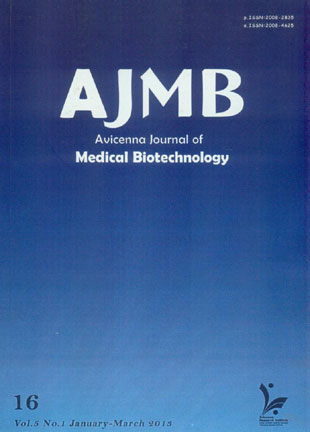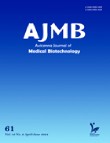فهرست مطالب

Avicenna Journal of Medical Biotechnology
Volume:5 Issue: 1, Jan-Mar 2013
- 70 صفحه،
- تاریخ انتشار: 1391/12/06
- تعداد عناوین: 9
-
-
Page 1
-
Page 2BackgroundThe transcription factor Oct-4, is an important marker of undifferentiating level and a key regulating factor for maintenance of pluripotency in cells. Establishment of an Oct-4 promoter-based reporter system is an appropriate tool for monitoring the differentiation of embryonic stem cells both in vivo and in vitro.MethodsIn the present study, we report construction of a recombinant vector, pDB2 Oct4 promoter/EGFP, in which expression of Enhanced Green Fluorescent Protein (EGFP) was controlled by the mouse Oct-4 promoter.ResultsIn transfected mouse embryonic stem cells with this vector, EGFP was predicted to be specifically expressed in pluripotency state. After transfection, high-level expression of EGFP under the control of Oct-4 promoter was observed in manipulated embryonic stem cells.ConclusionThus, our new cellular reporter showed that both the properties of embryonic cells and expression the EGFP could be of great help in studying the differentiating and reprogramming mechanisms of mESCs.Keywords: Embryonic stem cells, Transcription factors, Mice, Enhanced green fluorescent protein
-
Page 10BackgroundRNA interference-based gene silencing has recently been applied as an efficient tool for functional gene analysis. RORC2 is the key transcription factor orchestrating Th17 cells differentiation, the cells that are known as the pathogenic elements in various autoimmune diseases. The aim of this study was to design efficient siRNAs specific for RORC2 and to evaluate different criteria affecting their functionality.MethodsThree siRNA duplexes specific for RORC2 mRNA were designed. Th17 cells were produced from IL-6 and IL-1 treated cord blood CD4+ T cells. The T cells were transfected with three different designed siRNAs against RORC2 and the expression of RORC2 gene was measured using quantitative real time PCR.ResultsDifferent levels of RORC2 down regulation were observed in the presence of each of the designed siRNAs. Efficient siRNA with 91.1% silencing activity met the majority of the established bioinformatics criteria while the one with 46.6% silencing activity had more deviations from these criteria.ConclusionThe more bioinformatics criteria are considered, the more functionality were observed for silencing RORC2. However, the importance of the type of criteria per se should not be neglected. Although all recommended criteria are important for designing siRNA but their value is not the same.Keywords: RNAi, siRNA, Th17 cells
-
Page 20BackgroundFilamentous hemagglutinin (FHA) is one of the most important immunoprotective antigens of Bordetella pertussis (B.pertussis) and a major component of the acellular pertussis vaccine. In the present study, three overlapping recombinant fragments from the immunodominant region of FHA were produced and their immunogenicity was investigated.MethodsThree overlapping coding sequences of FHA antigen were amplified from B.pertussis genomic DNA by PCR. Amplified fragments were expressed in Escherichia coli (E. coli) BL21(DE3) strain and purified through His-tag using Nickel-based chromatography. Purified fragments were characterized by SDS-PAGE and Western blotting techniques. In vitro peripheral blood mononuclear cells (PBMC) proliferation and IFN-γ production were assessed in a limited number of healthy adults vaccinated with a commercial acellular pertussis vaccine in response to all purified FHA fragments by H3-Thymidine incorporation and ELISA, respectively.ResultsRecombinant FHA segments were successfully cloned and produced at high levels in E. coli BL21(DE3). SDS-PAGE and Western blot analyses confirmed their purity and reactivity. All three recombinant fragments together with a commercial native FHA were able to induce in vitro PBMC proliferation and IFN-γ production.ConclusionOur preliminary results suggest that these overlapping recombinant FHA fragments are immunogenic and may prove to be immuno-protective.Keywords: Bordetella pertussis, Filamentous hemagglutinin, Immunodominant, Prokaryotic expression, Recombinant antigen
-
Page 29BackgroundSaccharomyces boulardii (S. boulardii) is the best known probiotic yeast. The genetic engineering of this probiotic strain requires the availability of appropriate mutants to accept various gene constructs carrying different selection markers. As the auxotrophy selection markers are under focus, we have generated a ura3 auxotroph mutant of S. boulardii for use in further genetic manipulations.MethodsClassical UV mutagenesis was used for the generation of auxotroph mutants. The mutants were selected in the presence of 5-FOA (5-Fluoroorotic acid), uracil and uridine. Uracil auxotrophy phenotype was confirmed by the ability of mutants to grow in the presence of uracil and the lack of growth in the absence of this compound. To test whether the uracil auxotrophy phenotype is due to the inactivation of URA3, the mutants were transformed with a plasmid carrying the gene. An in vitro assay was used for the analysis of acid and bile resistance capacity of these mutantsResultsThree mutants were found to be ura3 auxotroph as they were able to grow only in the presence of uracil. When the URA3 gene was added, these mutants were able to grow normally in the absence of uracil. Further in vitro analysis showed that the acid and bile resistance capacity of one of these mutants is intact and similar to the wild type.ConclusionA uracil auxotroph mutant of the probiotic yeast, S. boulardii, was generated and characterized. This auxotroph strain may have potential applications in the production and delivery of the recombinant pharmacuetics into the intestinal lumen.Keywords: Probiotic, Recombinant proteins, Uracil, Yeasts
-
Page 35BackgroundInfectious Bursal Disease Virus (IBDV) causes a highly immunosuppressive disease in chickens and is a pathogen of major economic importance to the poultry industry worldwide. The VP2 protein is the major host-protective immunogen of IBDV and has been considered as a potential subunit vaccine against the disease. VP2 coding sequence was cloned in an inducible fungal vector and the protein was expressed in Aspergillus niger (A. niger).MethodsAiming at a high level of expression, a multicopy AMA1-pyrG-based episomal construct driven by a strong inducible promoter, glaA, was prepared and used in transformation of A. niger pyrG - protoplasts. SDS-PAGE and western blot analysis was carried out to confirm the expression of the protein.ResultsA number of pyrG+ positive transformants were isolated and the presence of expression cassette was confirmed. Western blot analysis of one of these recombinant strains using monospecific anti-VP2 antibodies demonstrated the successful expression of the protein. The recombinant protein was also detected by serum obtained from immunized chicken.ConclusionIn the present study, we have generated a recombinant A. niger strain expressing VP2 protein intracellulary. This recombinant strain of A. niger may have potential applications in oral vaccination against IBDV in poultry industry.Keywords: Aspergillus niger, Recombinant proteins, VP2 protein
-
Page 42BackgroundThe rise of opportunistic fungal infections highlights the need for development of new antimicrobial agents. Antimicrobial Peptides (AMPs) and Antifungal Peptides (AFPs) are among the agents with minimal resistance being developed against them, therefore they can be used as structural templates for design of new antimicrobial agents.MethodsIn the present study four antifungal peptidomimetic structures named C1 to C4 were designed based on plant defensin of Pisum sativum. Minimum inhibitory concentrations (MICs) for these structures were deter-mined against Aspergillus niger N402, Candida albicans ATCC 10231, and Saccharomyces cerevisiae PTCC 5052.ResultsC1 and C2 showed more potent antifungal activity against these fun-gal strains compared to C3 and C4. The structure C2 demonstrated a potent antifungal activity among them and could be used as a template for future study on antifungal peptidomemetics design. Sequences alignments led to identifying antifungal decapeptide (KTCENLADTY) named KTC-Y, which its MIC was determined on fungal protoplast showing 25 (μg/ml) against Asper-gillus fumigatus Af293.ConclusionThe present approach to reach the antifungal molecules seems to be a powerful approach in design of bioactive agents based on AMP mimetic identification.Keywords: Antifungal agents, Defensins, Drug design, Peptidomimetics, Protoplasts
-
Page 54BackgroundIn cancer patients, chemo and radiotherapy can cause infertility by damaging spermatogenesis process. This process is based on self-renewal and differentiation of a rare population of the testicular cells called Spermatogonial Stem Cells (SSCs). Scientists have tried to isolate, enrich and culture Human spermatogonial stem cells, hoping to resolve infertility problems in cancer recovered patients in the future.MethodsSpermatogonial stem cells were isolated and purified from human testicular biopsies sample consisting of at least 500,000 and at most 2,000,000 cells. Two enzymatic digestion steps were performed. Enriching methods, differential plating, and specific culture in serum-free medium with added growth factors: human GDNF, bFGF, EGF and LIF was performed on coated dishes.ResultsHuman spermatogonial stem cell clusters were observed after 7 to 10 days in specific culture, then after several passages and successful expanding duration of 52 days, the cells were evaluated by three layer immunocytochemistry test (LSAB) to stain GPR125 protein as a surface marker in human spermatogonial stem cells.ConclusionIn current study human spermatogonial stem cell were isolated and expanded with the least manipulations in comparison with the other usual isolation methods like florescent or magnetic activated cell sorting. In contrast to the other SSCs isolation and culture methods, this system is based on the testicular biopsies against large samples, thus suggested method in this study is closer to clinical usage in the future.Keywords: Culture, Enrichment, GPR125, Human spermatogonial stem cell, Infertility, Isolation
-
Page 62BackgroundSuccessful Embryo Transfer (ET) technique is a fateful step of all efforts to achieve live births from in vitro produced embryos in assisted reproductive techniques or in knockout, transgenic or cloned animal projects. Small reproductive tract of mice and limitation of current techniques may not well satisfy the requirements for mass production of genetically modified mice. Genetic abnormalities of embryos, receptivity and uterine contractions, expulsion of embryos, blood, mucus or bacterial contamination on the transfer pipette tip, technical problems and even animal strain may affect embryo transfer outcome.MethodsIn this study, two techniques of embryo transfer in mice were compared. In conventional technique the oviduct wall was punctured with a 30-gauge needle and the loaded Pasteur pipette with embryos and medium was inserted into the hole. In new technique, embryos that were loaded in modified micropipette with minimal medium were transferred directly to the oviduct by manual piston micro-pump easily. Embryo viability was evaluated considering the percentage of live healthy newborns.ResultsResults of the two techniques were compared by t-test within the NPAR1WAY procedure of SAS software (ver. 9.2). The average live birth rates in the novel methods was significantly higher (42.4%) than the conventional method (21.7%, p<0.05).ConclusionIn conclusion, using new embryo transfer technique improved birth rate by preventing embryos expulsion from the oviduct, saving time and easy transfer of embryos with minimum volume of medium.Keywords: Embryo transfer, Micropipette, Mice, Embryo


